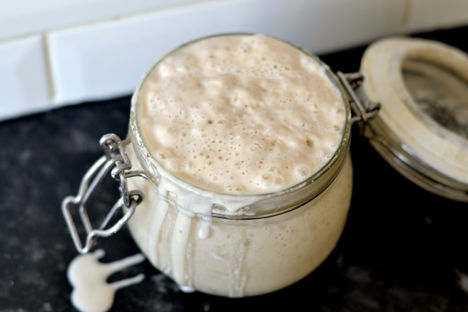When most people hear the phrase ‘sourdough’, they picture one thing: huge, open loaves, made mostly from white flour, with a crisp crust. However, sourdough is actually so much more than those (admittedly delicious) loaves of bread. You can use sourdough starter for any recipe where you’d normally use yeast: English muffins, waffles, sandwich bread and so much more.
There are lots of different ways to make sourdough starter, too, and lots of different theories about how to make the best one. The ultimate goal with a sourdough starter is to have something lively enough to give you towering, flavourful loaves of bread.
What is a sourdough starter?
It seems like magic. Day one you’ve just got a greyish paste of flour and water. Then days or weeks later, you have a tangy, bubbling ferment that’s so full of life it can crack through glass. Starters do start life as just flour and water, but they quickly become the loving home for various different bacteria and yeasts. And yes, you’ve read that right – bacteria too.
Although sourdough is often referred to as being made from ‘wild yeast’, sourdough starters contain both lactic acid bacteria (LAB) and yeasts. In short, yeast helps your bread rise, while LAB keep the sourdough starter acidic enough that dangerous microbes can’t survive. They also help sourdough taste pleasantly sour.
What do you need to make a sourdough starter?
Essentially, just flour and water. You can feed a sourdough starter all sorts of different types of flour, but white, wholewheat and rye are the most common. Unless you’re following a very specific gluten-free sourdough starter recipe, don’t use gluten-free flour in the place of regular white flour.
There’s debate about exactly what ratio is best, but most recipes use mostly white flour. Some, like Andrew Janjigian over at Wordloaf prefer to feed their starter with all white flour, while others prefer a little bit of rye in the mix. Rye ferments really well, so it’s useful to add in when you first start making your sourdough starter. However, it can ferment a little too well, and so using just white flour can keep the sourdough more ‘steady’ in between feeds.
How to make a sourdough starter
Metric
Imperial
- water
- white bread flour, or a mixture of white and wholewheat or rye
Mix equal parts flour and water in a clean container, such as a jar. Mix well then cover and leave for 48 hours
Remove half of the sourdough starter, and add the same amount of water and flour that you added in step 1
Repeat as needed every 24 hours for about a week, or until you have a bubbly, spongy and slightly sour smelling starter. If you get mould or if the starter smells bad, discard it and start again
What can you do with sourdough discard?
Sourdough discard is what you get when you feed the sourdough starter – it’s the part you throw away most of the time. But, it can be used to make anything where you would like a bit of extra flavour in your baking. Waffles and pancakes are a great place to start, as are simple crackers and flatbreads.
How do you store sourdough starter?
Most people keep their starter in the fridge – that way it doesn’t ferment too quickly and overproof between bakes. You can keep your starter at room temperature, but you will need to feed it more often – at least once a day.
Get in touch
Please sign in or register to send a comment to Great British Chefs.



